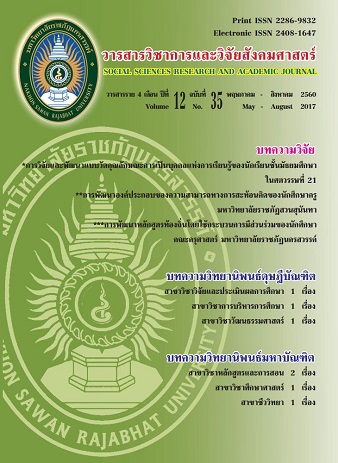การพัฒนารูปแบบการประเมินการเรียนรู้ในศตวรรษที่ 21 สำหรับสาระวิทยาศาสตร์ระดับชั้นมัธยมศึกษาปีที่ 4; A Development of the 21st Century Learning Assessment Model for Sciences Mathayomsuksa 4
Main Article Content
Abstract
การวิจัยครั้งนี้มุ่งพัฒนารูปแบบการประเมินการเรียนรู้ในศตวรรษที่ 21 สำหรับสาระวิทยาศาสตร์ ระดับชั้นมัธยมศึกษาปีที่ 4 โดยใช้วิธีวิจัยและพัฒนา วิเคราะห์ข้อมูลด้วย ค่าเฉลี่ย ส่วนเบี่ยงเบนมาตรฐาน ร้อยละ t-test One-way MANCOVA คะแนนพัฒนาการสัมพัทธ์ และอัตราพัฒนาการ ผลการวิจัยพบว่า รูปแบบที่พัฒนาขึ้นมุ่งประเมินความรู้ในเนื้อหาวิชาควบคู่ไปกับทักษะแห่งศตวรรษที่ 21 และเสริมสร้างแรงบันดาลใจในการเรียนรู้ เป็นการประเมินที่สมดุลระหว่างการประเมินเพื่อพัฒนาและเพื่อสรุปผล มีภาระงานการประเมินที่เน้นการปฏิบัติและครอบคลุมทั้งการประเมินเพื่อการเรียนรู้ เสมือนการเรียนรู้ และเพื่อสรุปผลการเรียนรู้ ที่ผสานเข้าเป็นเนื้อเดียวกับการเรียนเชิงรุก เปิดโอกาสให้นักเรียนได้ประเมินตนเองและเพื่อน มีเกณฑ์ประเมินที่ชัดเจน เหมาะสม มีกระบวนการให้ข้อมูลย้อนกลับและสะท้อนการเรียนรู้ที่ต่อเนื่องและทันท่วงทีทั้งในและนอกห้องเรียน โดยใช้เทคโนโลยีและสื่อสังคมออนไลน์ช่วยสนับสนุน ผลการเรียนอิงความก้าวหน้า โครงสร้างของรูปแบบมี 8 องค์ประกอบ คือ จุดมุ่งหมายของการประเมิน ผลลัพธ์ของการเรียนรู้ เกณฑ์การประเมิน ภาระงานการประเมิน สมดุลการประเมิน กระบวนการให้ข้อมูลย้อนกลับ การเรียนเชิงรุก เทคโนโลยีสนับสนุนมีกระบวนการประเมิน 5 ขั้น คือ วิเคราะห์และจัดเตรียมข้อมูลเบื้องต้น ออกแบบการประเมินที่สมดุล ผสาน
การเรียนเชิงรุกและการประเมินที่สมดุล เก็บรวบรวมและประมวลผลข้อมูล และนำผลการประเมินไปใช้
ผลการใช้รูปแบบพบว่า กลุ่มทดลองมีคะแนนพัฒนาการสูงขึ้นทุกด้าน มีผลสัมฤทธิ์ทางการเรียน แรงบันดาลใจในการเรียนรู้ และทักษะแห่งศตวรรษที่ 21 สูงกว่ากลุ่มควบคุม อย่างมีนัยสำคัญทางสถิติที่ระดับ .05 ผู้เรียนพึงพอใจต่อรูปแบบในระดับมาก และรูปแบบมีประสิทธิภาพอยู่ในระดับมาก
Abstract
The purpose of this research was to developed the 21st century learning assessment model for sciences in Mathayom Suksa 4 through research and development. The statistics used in this study were means, standard deviation, percentage, t - test, One - way MANCOVA, relative gain score and growth rate. The study revealed that the developed assessment model aimed to assess the content knowledge along with the 21st century skills and enhanced the inspiration in learning for students. The model was balanced between formative and summative assessments. It focused on performance assessment through assessment tasks and included the assessment for learning, assessment as learning and assessment of learning which embedded in active learning. Moreover, the students were engaged in the self- and peer-assessments with clear and appropriate criteria. There were feedback and reflection processes, ongoing and promptly for learning both inside and outside the classroom, using information technology and social media to support the assessment. However, the learning outcomes were based on the improvement of learning according to the expected results. The model consisting of 8 elements were 1) assessment goals 2) learning outcomes 3) assessment criteria 4) assessment tasks 5) balanced assessment 6) feedback process 7) active learning 8) supporting technology. The assessment process consisting of 5 steps were 1) basic analyzing and providing information 2) balanced assessment design 3) combining active learning and balanced assessment 4) data gathering and processing 5) implementation of assessment results. The students who were assessed through the model gained more scores in all parts, and the learning outcomes, inspiration in learning and 21st. Century skills were higher than the control group at the 0.05 level ; moreover, they were satisfied at a 'much' level with the model. The developed assessment model was highly effective at a ‘much level’.


